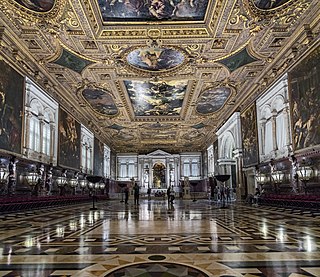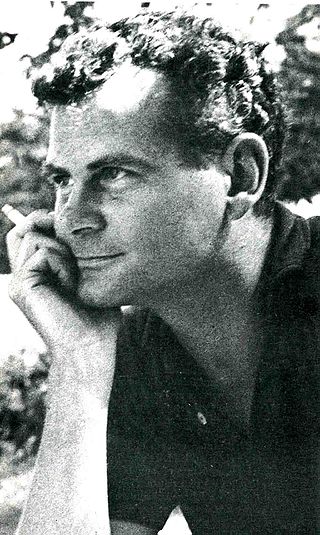Related Research Articles

Ernst Heinrich Krenek was an Austrian, later American, composer of Czech origin. He explored atonality and other modern styles and wrote a number of books, including Music Here and Now (1939), a study of Johannes Ockeghem (1953), and Horizons Circled: Reflections on my Music (1974). Krenek wrote two pieces using the pseudonym Thornton Winsloe.

Olga Neuwirth is an Austrian contemporary classical composer, visual artist and author. She gained fame mainly through her operas and music theater works, which often deal with topical and decidedly political themes of identity, violence and intolerance.
Louise Juliette Talma was an American composer, academic, and pianist. After studies in New York and in France, piano with Isidor Philipp and composition with Nadia Boulanger, she focused on composition from 1935. She taught at the American Conservatory in Fontainebleau, and at Hunter College. Her opera The Alcestiad was the first full-scale opera by an American woman staged in Europe. She was the first women in the National Institute of Arts and Letters and being awarded the Sibelius Medal for Composition.
The viola sonata is a sonata for viola, sometimes with other instruments, usually piano. The earliest viola sonatas are difficult to date for a number of reasons:

Berthold Goldschmidt was a German Jewish composer who spent most of his life in England. The suppression of his work by Nazi Germany, as well as the disdain with which many Modernist critics elsewhere dismissed his "anachronistic" lyricism, stranded the composer in the wilderness for many years before he was given a revival in his final decade.
Alice Anne LeBaron is a United States composer and harpist.
Avo Sõmer is an American musicologist music theorist, and composer, of Estonian birth.

Franz Salmhofer was an Austrian composer, clarinetist and conductor. He studied the clarinet, composition and musicology in Vienna. Salmhofer served successively as Kapellmeister of the Burgtheater, Director of the Vienna State Opera and Director of the Vienna Volksoper and composed a number of works, few of which are played today.

Karl V. is an opera, described as a Bühnenwerk mit Musik by Ernst Krenek, his opus 73. The German libretto is by the composer. His student Virginia Seay collaborated with him on the English translation of the libretto.
Johanna Magdalena Beyer was a German-American composer and pianist.

Lucijan Marija Škerjanc was a Slovene composer, music pedagogue, conductor, musician, and writer who was accomplished on and wrote for a number of musical instruments such as the piano, violin and clarinet. His style reflected late romanticism with qualities of expressionism and impressionism in his pieces, often with a hyperbolic artistic temperament, juxtaposing the dark against melodic phrases in his music.
Robert William Witt was an American neoclassical and experimental composer. A native of Youngstown, Ohio, he was a composer, pianist, and professor of music at Dana School of Music at Youngstown State University. Like his mentor, Vincent Persichetti, Witt was well known for exploration of new musical forms and for integrating old themes into new works.

Gladys Mercedes Nordenstrom was an American composer.
Clare Shore is an American composer, music educator mezzo-soprano, and conductor.
Beverly Grigsby née Pinsky is an American composer, musicologist and electronic/computer music pioneer.

Threni: id est Lamentationes Jeremiae Prophetae, usually referred to simply as Threni, is a musical setting by Igor Stravinsky of verses from the Book of Lamentations in the Latin of the Vulgate, for solo singers, chorus and orchestra. It is important among Stravinsky's compositions as his first and longest completely dodecaphonic work, but is not often performed. It has been described as "austere" but also as a "culminating point" in his career as an artist, "important both spiritually and stylistically" and "the most ambitious and structurally the most complex" of all his religious compositions, and even "among Stravinsky's greatest works".
Edith Borroff was an American musicologist and composer. Her compositions include over 60 commissioned works, including pieces for the stage; for her primary instrument—the organ; choral, vocal, and orchestral music; and several critical editions of works by previous composers such as Jubilate by J.-J. Cassanéa de Mondonville. She also wrote at least 7 books, including the textbook Music in Europe and the United States: a History, as well as various peer-reviewed articles and publications.

John Lessard was an American composer and music educator noted among peers for his eloquent and dramatic neo-classical works for piano and voice, chamber ensembles, and orchestra, as well as for his playful pieces for mixed percussion ensembles. He was also an accomplished pianist and conductor.

Marius Flothuis, born and died in Amsterdam, was a Dutch composer, musicologist and music critic.
References
- 1 2 Ploeser, Virginia Seay (1 Dec 2015). "San Jose Mercury News/San Mateo County Times". Legacy.com . Retrieved 2022-10-25.
- ↑ Ewen, David (1949). American Composers Today: A Biographical and Critical Guide. H.W. Wilson Company.
- 1 2 3 4 Webmaster, Bruce Eskander-SPHSAA. "Virginia Claire Seay (Ploeser) (Deceased), South Pasadena, CA California last lived in Redwood City, CA". www.sphsaa.org. Retrieved 2022-10-25.
- 1 2 Colby, Frank Harvey (1945). The Pacific Coast Musician. Colby and Pryibil.
- ↑ Music Clubs Magazine. National Federation of Music Clubs. 1944.
- 1 2 Stewart, John Lincoln (1991-01-01). Ernst Krenek: The Man and His Music. University of California Press. ISBN 978-0-520-07014-1.
- 1 2 Trotter, William R. (1995). Priest of Music: The Life of Dimitri Mitropoulos. Hal Leonard Corporation. ISBN 978-0-931340-81-9.
- 1 2 Hughes, Charles (1946). "Review of Hamline Studies in Musicology". The Journal of Aesthetics and Art Criticism. 4 (4): 254. doi:10.2307/426540. ISSN 0021-8529. JSTOR 426540.
- ↑ Arts, Hamline University School of Fine (1945). Hamline Studies in Musicology. Burgess Publishing Company.
- ↑ Krenek, Ernst (1945). Hamline Studies in Musicology. Hamline Univ. ISBN 978-0-598-97477-8.
- ↑ The Clarinet. Department of Music, Idaho State University. 1980.
- ↑ "Heather Fetrow". Heather Fetrow. Retrieved 2022-10-25.
- ↑ Stern, Susan (1978). Women composers : a handbook. Metuchen, N.J.: Scarecrow Press. ISBN 0-8108-1138-3. OCLC 3844725.
- ↑ Stewart-Green, Miriam (1980). Women composers : a checklist of works for the solo voice. Boston, Mass.: G.K. Hall. ISBN 0-8161-8498-4. OCLC 6815939.